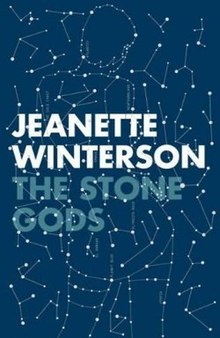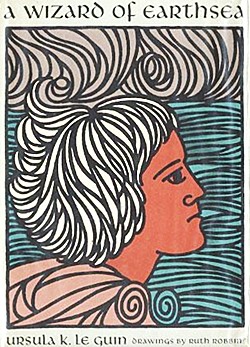
A Wizard of Earthsea is a fantasy novel written by American author Ursula K. Le Guin and first published by the small press Parnassus in 1968. It is regarded as a classic of children's literature and of fantasy, within which it is widely influential. The story is set in the fictional archipelago of Earthsea and centers on a young mage named Ged, born in a village on the island of Gont. He displays great power while still a boy and joins a school of wizardry, where his prickly nature drives him into conflict with a fellow student. During a magical duel, Ged's spell goes awry and releases a shadow creature that attacks him. The novel follows Ged's journey as he seeks to be free of the creature.

Ursula Kroeber Le Guin was an American author. She is best known for her works of speculative fiction, including science fiction works set in her Hainish universe, and the Earthsea fantasy series. Her work was first published in 1959, and her literary career spanned nearly sixty years, producing more than twenty novels and over a hundred short stories, in addition to poetry, literary criticism, translations, and children's books. Frequently described as an author of science fiction, Le Guin has also been called a "major voice in American Letters". Le Guin said she would prefer to be known as an "American novelist".

The Dispossessed is a 1974 anarchist utopian science fiction novel by American writer Ursula K. Le Guin, one of her seven Hainish Cycle novels. It is one of a small number of books to win all three Hugo, Locus and Nebula Awards for Best Novel. It achieved a degree of literary recognition unusual for science fiction due to its exploration of themes such as anarchism and revolutionary societies, capitalism, utopia, individualism, and collectivism.
The Hainish Cycle consists of a number of science fiction novels and stories by Ursula K. Le Guin. It is set in a future history in which civilizations of human beings on planets orbiting a number of nearby stars, including Terra ("Earth"), are contacting each other for the first time and establishing diplomatic relations, and setting up a confederacy under the guidance of the oldest of the human worlds, peaceful Hain. In this history, human beings did not evolve on Earth but were the result of interstellar colonies planted by Hain long ago, which was followed by a long period when interstellar travel ceased. Some of the races have new genetic traits, a result of ancient Hainish experiments in genetic engineering, including people who can dream while awake, and a world of hermaphroditic people who only come into active sexuality once a month, not knowing which sex will manifest in them. In keeping with Le Guin's style, she uses varied social and environmental settings to explore the anthropological and sociological outcomes of human evolution in those diverse environments.

The Earthsea Cycle, also known as Earthsea, is a series of high fantasy books written by the American author Ursula K. Le Guin. Beginning with A Wizard of Earthsea (1968), The Tombs of Atuan, (1970) and The Farthest Shore (1972), the series was continued in Tehanu (1990), and Tales from Earthsea and The Other Wind. In 2018, all the novels and short stories were published in a single volume, The Books of Earthsea: The Complete Illustrated Edition, with artwork by Charles Vess.

Jeanette Winterson is an English author.

Rocannon's World is a science fiction novel by American writer Ursula K. Le Guin, her literary debut. It was published in 1966 as an Ace Double, along with Avram Davidson's The Kar-Chee Reign, following the tête-bêche format. Though it is one of Le Guin's many works set in the universe of the technological Hainish Cycle, the story itself has many elements of heroic fantasy. The hero Gaveral Rocannon encounters lords who live in castles and wield swords, and other races much like fairies and gnomes, in his travels on a backward planet.

Planet of Exile is a 1966 science fiction novel by American writer Ursula K. Le Guin, part of her Hainish Cycle. It was first published as an Ace Double following the tête-bêche format, bundled with Mankind Under the Leash by Thomas M. Disch. In 2017, the rights for a movie were acquired by Los Angeles Media Fund.

City of Illusions is a 1967 science fiction novel by American writer Ursula K. Le Guin. It is set on Earth in the distant future, and is part of her Hainish Cycle. City of Illusions lays the foundation for the Hainish cycle which is a fictional universe in which the majority of Ursula K. Le Guin's science fiction novels take place.

Four Ways to Forgiveness is a collection of four short stories and novellas by American writer Ursula K. Le Guin. All four stories are set in the future and deal with the planets Yeowe and Werel, both members of the Ekumen, a collective of planets used by Le Guin as part of the background for many novels and short stories in her Hainish Cycle. In 2017 it was reissued in the second volume of Hainish Novels & Stories and as an e-book, augmented with a fifth related story by Le Guin, as Five Ways to Forgiveness.
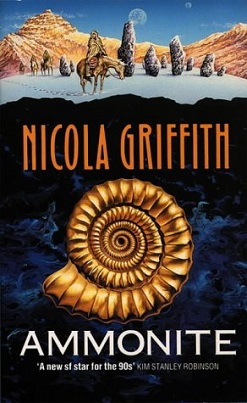
Ammonite is British-American author Nicola Griffith's debut novel, which was published in 1992. Styled as a meditation on queer ideologies, the novel explores themes of gender, illusion, and humanity. Griffith examines whether a world run by women would be a gentler or better one. American author Ursula Le Guin cited Ammonite as “a knock-out first novel, with strong, likeable characters, a compelling story, and a very interesting take on gender”.
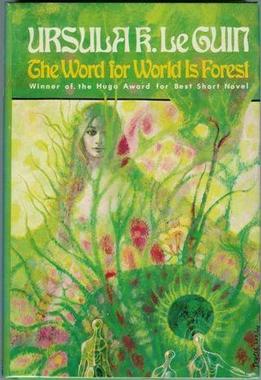
The Word for World Is Forest is a science fiction novella by American writer Ursula K. Le Guin, first published in the United States in 1972 as a part of the anthology Again, Dangerous Visions, and published as a separate book in 1976 by Berkley Books. It is part of Le Guin's Hainish Cycle.

Oranges Are Not the Only Fruit is a novel by Jeanette Winterson published in 1985 by Pandora Press. It is a coming-of-age story about a lesbian who grows up in an English Pentecostal community. Key themes of the book include transition from youth to adulthood, complex family relationships, same-sex relationships, organised religion and the concept of faith.
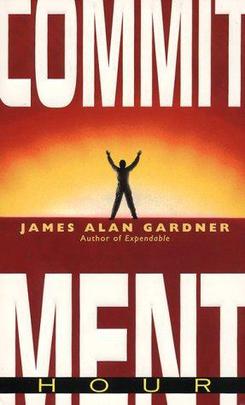
Commitment Hour is a science fiction novel by Canadian writer James Alan Gardner, published in 1998. The novel is set in Gardner's "League of Peoples's" futuristic universe, and plays out in the small, isolated village of Tober Cove. Set on post-apocalyptic Earth, Tober Cove most resembles a rural, seventeenth century fishing village, with one exception: every year, everyone below the age of 21 changes gender. At the age of twenty-one, the people of the village must "commit" to being male, female or both in the form of a Hermaphrodite, forever. Commitment Hour follows the day leading up to the main character's hour of commitment.

The Eye of the Heron is a 1978 science fiction novel by American author Ursula K. Le Guin which was first published in the science fiction anthology Millennial Women.
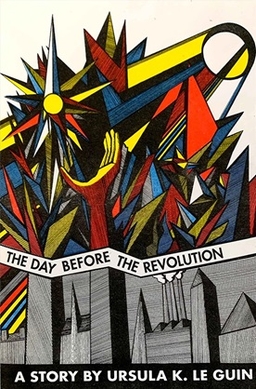
"The Day Before the Revolution" is a science fiction short story by American writer Ursula K. Le Guin. First published in the science fiction magazine Galaxy in August 1974, it was anthologized in Le Guin's 1975 collection The Wind's Twelve Quarters and in several subsequent collections. Set in Le Guin's fictional Hainish universe, the story has strong connections to her novel The Dispossessed, and is sometimes referred to as a prologue to the longer work, though it was written later.

The Left Hand of Darkness is a science fiction novel by the American writer Ursula K. Le Guin. Published in 1969, it became immensely popular, and established Le Guin's status as a major author of science fiction. The novel is set in the fictional Hainish universe as part of the Hainish Cycle, a series of novels and short stories by Le Guin, which she introduced in the 1964 short story "The Dowry of Angyar". It was fourth in sequence of writing among the Hainish novels, preceded by City of Illusions, and followed by The Word for World Is Forest.

Climate fiction is literature that deals with climate change. Generally speculative in nature but inspired by climate science, works of climate fiction may take place in the world as we know it, in the near future, or in fictional worlds experiencing climate change. The genre frequently includes science fiction and dystopian or utopian themes, imagining the potential futures based on how humanity responds to the impacts of climate change. Climate fiction typically involves anthropogenic climate change and other environmental issues as opposed to weather and disaster more generally. Technologies such as climate engineering or climate adaptation practices often feature prominently in works exploring their impacts on society.
"The Dowry of Angyar" is a science fiction short story by American writer Ursula K. Le Guin, first published in 1964. It is the first work of the Hainish Cycle. The story is set on a fictional planet of the star Fomalhaut and follows a highborn woman as she tries to track down a family heirloom. It was framed by commentary from ethnologists studying the intelligent life forms of the Fomalhaut system. The story drew from Norse mythology, including the legend of the Brísingamen, and explored the concept of time dilation. "The Dowry of Angyar" drew comments for its stylistic devices, while a review praised Le Guin's writing as "crystalline prose". It was later used as the prologue to Le Guin's 1966 novel Rocannon's World. In later publications, including in the 1975 anthology The Wind's Twelve Quarters, the story was given the title "Semley's Necklace".

The Stone Sky is a 2017 science fantasy novel by American writer N. K. Jemisin. It was awarded the Hugo Award for Best Novel, the Nebula Award for Best Novel, and the Locus Award for Best Fantasy Novel in 2018. Reviews of the book upon its release were highly positive. It is the third volume in the Broken Earth series, following The Fifth Season and The Obelisk Gate, both of which also won the Hugo Award.
